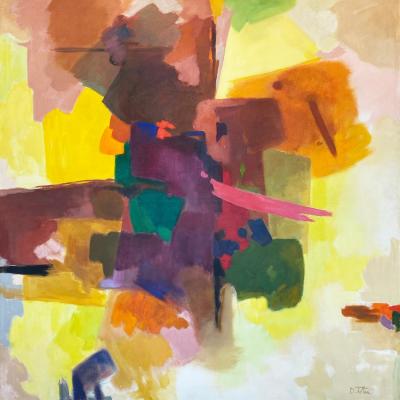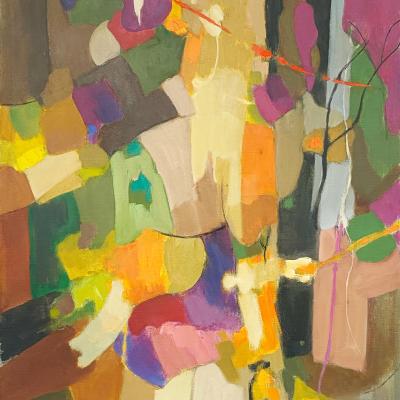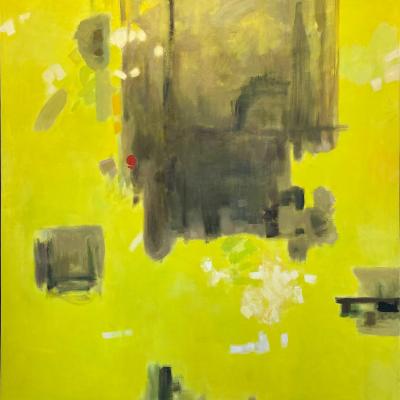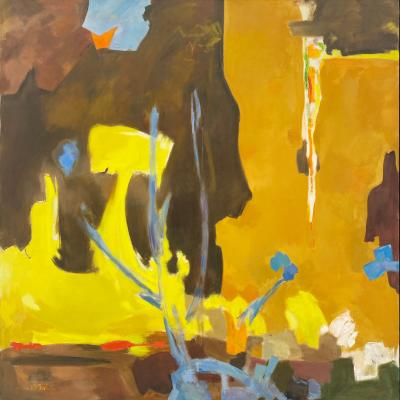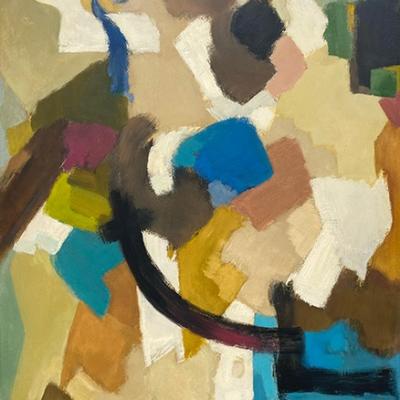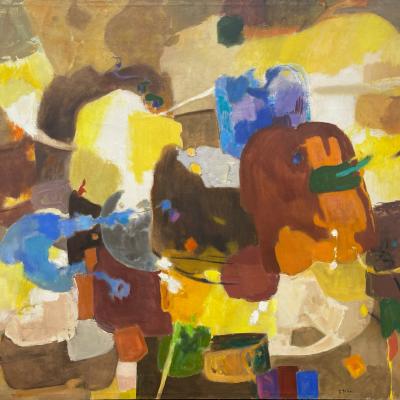-
 Don Totten1903 - 1967Color Structure, 1960Signed: D Totten lower rightOil on canvas59 1/2 x 59 inches
Don Totten1903 - 1967Color Structure, 1960Signed: D Totten lower rightOil on canvas59 1/2 x 59 inches
Framed: 61 5/8 x 60 3/4 inches -
 Don Totten1903 - 1967Baroque, 1960Signed: D Totten lower rightOil on canvas61 1/2 x 72 inches
Don Totten1903 - 1967Baroque, 1960Signed: D Totten lower rightOil on canvas61 1/2 x 72 inches
Framed: 63 3/8 x 73 7/8 inches -
 Don Totten1903 - 1967Pattern, 1950-60Signed: D Totten lower rightOil on canvas22 1/2 x 30 inches
Don Totten1903 - 1967Pattern, 1950-60Signed: D Totten lower rightOil on canvas22 1/2 x 30 inches
Framed: 24 3/8 x 31 3/4 inches -
 Don Totten1903 - 1967Palos Verdes, 1960'sSigned: D Totten lower rightOil on canvas48 x 49 1/4inches
Don Totten1903 - 1967Palos Verdes, 1960'sSigned: D Totten lower rightOil on canvas48 x 49 1/4inches
Framed: 50 x 51 1/4 inches -
 Don Totten1903 - 1967Synchrony, 1960sSigned: D Totten lower rightOil on canvas61 1/2 x 71 3/4
Don Totten1903 - 1967Synchrony, 1960sSigned: D Totten lower rightOil on canvas61 1/2 x 71 3/4
Framed: 63 1/4 x 73 1/2 inches -
 Don TottenAmerican 1903 - 1967Abstract I, 1940sSigned: D Totten lower leftOil on burlap19 x 16 1/8 inches
Don TottenAmerican 1903 - 1967Abstract I, 1940sSigned: D Totten lower leftOil on burlap19 x 16 1/8 inches
Framed: 20 3/4 x 17 3/4 inches
-
 Don Totten1903 - 1967Abstraction, 1960sSigned: D Totten lower rightOil on canvas36 x 30 inches
Don Totten1903 - 1967Abstraction, 1960sSigned: D Totten lower rightOil on canvas36 x 30 inches
Framed: 37 7/8 x 31 7/8 inches -
 Don Totten1903 - 1967Abstraction, 1950sSigned: D.Totten lower rightOil on canvas24 1/8 x 30 inches
Don Totten1903 - 1967Abstraction, 1950sSigned: D.Totten lower rightOil on canvas24 1/8 x 30 inches
Framed: 26 1/8 x 31 7/8 inches -
 Don Totten1903 - 1967Lyric, 1960Titled and dated verso
Don Totten1903 - 1967Lyric, 1960Titled and dated verso
Signed D. Totten lower leftOil on Masonite18 x 32 inches
Framed: 19 3/4 x 33 3/4 inches -
 Don Totten1903 - 1967Spring, 1950'sSigned: D. Totten lower rightOil on canvas24 1/2 x 22 inches,
Don Totten1903 - 1967Spring, 1950'sSigned: D. Totten lower rightOil on canvas24 1/2 x 22 inches,
Framed: 26 3/8 x 23 3/4 inches -
 Don Totten1903 - 1967Floating Forms, 1960sSigned: D Totten lower rightOil on Canvas72 x 67 1/4 inches
Don Totten1903 - 1967Floating Forms, 1960sSigned: D Totten lower rightOil on Canvas72 x 67 1/4 inches
Framed: 73 1/2 x 69 1/4 inches -
 Don Totten1903 - 1967Flowers, 1960sSigned lower right and versoOil on masonite24 x 14 inches
Don Totten1903 - 1967Flowers, 1960sSigned lower right and versoOil on masonite24 x 14 inches
Framed: 25 7/8 x 15 7/8 inches -
 Don Totten1903 - 1967Forms in Nature, 1940sSigned: D.Totten lower leftOil on burlap30 1/4 x 16 inches
Don Totten1903 - 1967Forms in Nature, 1940sSigned: D.Totten lower leftOil on burlap30 1/4 x 16 inches
Framed: 32 x 18 inches -
 Don Totten1903 - 1967Pale Light, 1960sSigned: D.Totten lower rightOil on canvas25 x 24 inches
Don Totten1903 - 1967Pale Light, 1960sSigned: D.Totten lower rightOil on canvas25 x 24 inches
Framed: 26 3/4 x 26 inches -
 Don Totten1903 - 1967Structure, 1960sSigned: D. Totten lower rightOil on canvas72 x 61 3/4 inches
Don Totten1903 - 1967Structure, 1960sSigned: D. Totten lower rightOil on canvas72 x 61 3/4 inches
Framed: 74 x 63 1/2 inches -
 Don Totten1903 - 1967Eo, 1960ssigned: D Totten lower rightOil on canvas72 x 67 1/2 inches
Don Totten1903 - 1967Eo, 1960ssigned: D Totten lower rightOil on canvas72 x 67 1/2 inches
Framed: 73 3/4 x 69 1/2 inches -
 Don Totten1903 - 1967Colors , 1950sSigned: D. Totten lower right and Estate Stamp (verso)Oil on masonite25 x 27 inches
Don Totten1903 - 1967Colors , 1950sSigned: D. Totten lower right and Estate Stamp (verso)Oil on masonite25 x 27 inches
Framed: 26 5/8 x 28 3/4 inches -
 Don Totten1903 - 1967Dissection, 1950sSigned: Estate stamp (verso)Oil on Masonite23 x 22 3/8 inches
Don Totten1903 - 1967Dissection, 1950sSigned: Estate stamp (verso)Oil on Masonite23 x 22 3/8 inches
Framed: 25 x 24 inches
-
 Don Totten1903 - 1967Drawing on Top, 1950'sSigned: D. Totten lower right
Don Totten1903 - 1967Drawing on Top, 1950'sSigned: D. Totten lower right
Estate Stamped versoOil on canvas30 1/8 x 26 1/8 inches
Framed: 31 7/8 x 27 7/8 inches -
 Don Totten1903 - 1967Early Abstraction, Circa 1940Signed: D. Totten lower right
Don Totten1903 - 1967Early Abstraction, Circa 1940Signed: D. Totten lower right
Estate Stamped versoOil on Masonite19 7/8 x 23 7/8 inches
Framed: 21 3/4 x 25 5/8 inches -
 Don Totten1903 - 1967Forms , 1940estate stamped versoOil on Masonite on stretcher37 3/4 x 48 inches
Don Totten1903 - 1967Forms , 1940estate stamped versoOil on Masonite on stretcher37 3/4 x 48 inches
Framed: 39 1/4 x 49 5/8 inches -
 Don Totten1903 - 1967Grays, 1950'sSigned: D Totten lower rightOil on masonite25 x 34 1/2 inches
Don Totten1903 - 1967Grays, 1950'sSigned: D Totten lower rightOil on masonite25 x 34 1/2 inches
Framed: 27 x 36 1/4 inches -
 Don Totten1903 - 1967Interior, 1940sSigned lower rightOil on canvas48 1/4 x 30 inches
Don Totten1903 - 1967Interior, 1940sSigned lower rightOil on canvas48 1/4 x 30 inches
Framed: 49 3/4 x 31 1/2 inches -
 Don Totten1903 - 1967Nature, 1950sSigned lower right and estate stamped versoOil on Masonite29 x 31 1/8 inches
Don Totten1903 - 1967Nature, 1950sSigned lower right and estate stamped versoOil on Masonite29 x 31 1/8 inches -
 Don Totten1903 - 1967Still Life with Gourds, 1940'sSigned: Don Totten
Don Totten1903 - 1967Still Life with Gourds, 1940'sSigned: Don Totten
Estate stamp (verso)Oil on masonite33 x 30 inches
Framed: 34 1/2 x 31 1/2 inches -
 Don Totten1903 - 1967Studio, 1940'sSigned: Estate stamp (verso)Oil on Masonite17 7/8 x 14 7/8
Don Totten1903 - 1967Studio, 1940'sSigned: Estate stamp (verso)Oil on Masonite17 7/8 x 14 7/8
Framed: 19 5/8 x 16 1/2 inches -
 Don Totten1903 - 1967Arizona 2, 1960sSigned: D Totten lower leftOil on canvas61 1/2 x 59 3/4 inches
Don Totten1903 - 1967Arizona 2, 1960sSigned: D Totten lower leftOil on canvas61 1/2 x 59 3/4 inches
Framed: 63 3/8 x 61 5/8 inches -
 Don Totten1903 - 1967Color Study, 1960sSigned: D Tottten lower rightOil on canvas25 1/8 x 48 inches
Don Totten1903 - 1967Color Study, 1960sSigned: D Tottten lower rightOil on canvas25 1/8 x 48 inches
Framed: 27 3/8 x 49 7/8 inches -
 Don Totten1903 - 1967Composition Blue, 1960sunsignedOil on canvas48 x 25 1/2
Don Totten1903 - 1967Composition Blue, 1960sunsignedOil on canvas48 x 25 1/2 -
 Don Totten1903 - 1967Connection, 1950sSigned: D Totten lower rightOil on Masonite48 x 42 inches
Don Totten1903 - 1967Connection, 1950sSigned: D Totten lower rightOil on Masonite48 x 42 inches
Framed: 49 7/8 x 43 7/8 inches
-
 Don Totten1903 - 1967Construction, circa 1965Signed: D Totten lower rightOil on canvas48 x 49 1/2 inches
Don Totten1903 - 1967Construction, circa 1965Signed: D Totten lower rightOil on canvas48 x 49 1/2 inches
49 7/8 x 51 3/8 inches -
 Don Totten1903 - 1967Counterpoint, circa 1960Signed: D Totten lower rightOil on Masonite34 3/8 x 25 inches
Don Totten1903 - 1967Counterpoint, circa 1960Signed: D Totten lower rightOil on Masonite34 3/8 x 25 inches
36 1/8 x 27 3/4 inches -
 Don Totten1903 - 1967Los Angeles, circa 1960Signed: D. Totten lower right and D Totten (verso)Oil on Masonite26 x 21 inches
Don Totten1903 - 1967Los Angeles, circa 1960Signed: D. Totten lower right and D Totten (verso)Oil on Masonite26 x 21 inches
Framed: 27 7/8 x 22 7/8 inches -
 Don Totten1903 - 1967Portuguese Bend, 1958Signed: D Totten lower rightOil on canvas48 x 55 inches
Don Totten1903 - 1967Portuguese Bend, 1958Signed: D Totten lower rightOil on canvas48 x 55 inches
Framed: 49 7/8 x 56 1/2 inches -
 Don Totten1903 - 1967Semblances, 1960sSigned: Totten lower rightOil on canvas40 x 48 inches
Don Totten1903 - 1967Semblances, 1960sSigned: Totten lower rightOil on canvas40 x 48 inches
Framed: 41 7/8 x 49 7/8 inches -
 Don Totten1903 - 1967Untitled, circa 1950Signed: D. Totten lower leftOil on canvas34 x 39 inches
Don Totten1903 - 1967Untitled, circa 1950Signed: D. Totten lower leftOil on canvas34 x 39 inches
Framed: 35 3/4 x 41 inches -
 Don Totten1903 - 1967UntitledSigned: D Totten lower rightOil on canvas22 x 33 1/2 inches
Don Totten1903 - 1967UntitledSigned: D Totten lower rightOil on canvas22 x 33 1/2 inches
Frame: 23 x 34 1/2 inches
Overview
America saw the emergence of two prominent schools of abstraction, established on the East and West coasts from the late 1930s through the 1970s. On the West Coast, artists like Clifford Still, Mark Rothko, and Richard Diebenkorn led the way in exploring abstraction, paving the path for successors such as Don Totten, who continued this artistic evolution.
Don Totten exhibited a remarkable talent for visual storytelling, creativity, and narrative sensibility from an early age. His formal art education took him to the Otis Art Institute in California, where he delved into color theory, composition, and expressive form.
In the late 1920s, Totten joined the Los Angeles Art Students’ League, where he studied under the mentorship of Stanton Macdonald Wright. Wright's European training and guidance significantly enhanced Totten's technical abilities and color sensitivity. The development of the Synchromism movement by Wright also profoundly influenced Totten, leaving a lasting impact that would resonate throughout his career.
From 1938 to 1940, Totten served as the Director of the League, skillfully navigating the challenges posed by the Great Depression and World War II. His own work is marked by a level of quality, sophistication, and appeal that is truly impressive. A dedicated artist, Totten focused on his craft rather than self-promotion.
At Taylor | Graham, we proudly include Totten alongside notable artists such as Edward Dugmore, John Grillo, John Saccaro, MacDonald-Wright, and Sam Francis.
